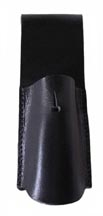A few thoughts to throw in..........
Back in the mid 1970's when I first began doing AWI as a Continental Marine, we had nowhere near the documentation sources that are so easily found on the internet today. Though some folks on the East Coast and particularly those in the BAR (Brigade of the American Revolution) probably knew about the British pattern Bayonet Frogs; to my knowledge - almost no one or no one knew about them in the Midwest where I was stationed and reenacted. NO ONE listed repro's of them in a nationally known catalogue at the time. When I had visited Colonial Williamsburg for the first time in 1975, no one wore them or displayed them, either. We knew of these frogs, but the earliest date we had was 1805 from an English ship that had sunk on that date.
Where we got the absolute best information on these frogs and bayonet scabbards was from the excavations of the French and Indian War period Pennsylvania frontier fort, Fort Ligonier. That fort was abandoned in the FIW, so anything found there in the archeological record HAD to be no later than that period. The stunning thing about those excavations was the soil was such that leather almost did not rot away in the ground. They found this type of British bayonet frogs and British bayonet scabbards buried there in such remarkably good condition; I'm only exaggerating a bit when I write they could almost have been used once some conditioning leather oil was applied.
When I first began collecting/making my gear for my Black Watch impression, I mentioned I was going to make most of my own leather goods. Another member brought me photo copies of pictures of the bayonet frogs and scabbards found at Fort Ligonier and my jaw bounced off the ground in shock when I saw them. Included in the information was a pattern for the British Bayonet Frog, but I found out it was a bit too small when I made the first one, so I sized it up on my second one. That's also where it was mentioned the four sets of rivets and burs were made of IRON and not copper or brass like most of the repro's made today.
I am not going to admit the lengths I went to find IRON rivets and burs, including searching English sources, but none are made anymore. Blacksmiths I knew either would not make them out of real Iron or the cost was too high. BTW, period hand wrought Iron doesn't rust as easily as modern steel. They did "blacken" period Iron rivets and burs to keep them from rusting as quickly by painting them, but that was done after British Ordnance procured them. So I decided to use modern stainless steel rivets and burs in the correct size and I hand filed and distressed them a bit to look like Iron. This led to an amusing story.
On my first inspection I stood in full kit, my Captain could not find a single thing wrong with me or my gear and trust me, he looked very, VERY hard. (He was a retired US Army Captain and had really looked forward to finding a discrepancy on me because he knew I was a retired Marine. Grin.) I had forgotten to "blacken" the rivets and burrs on my bayonet frog, though. When he spotted the rivets and burrs and in a surprised voice he said, "(Cripes) you even POLISHED the rivets on your bayonet frog?!!" Thinking quickly, I replied, "Sor, are we Privates not required to polish all bare Iron parts on our Firelock, accoutrements and gear, SOR?" He just shook his head.
Finally he looked down at my "well black balled" shoes and shined brass shoe buckles and asked, "Those are pretty fancy shoe buckles you are wearing, Private." In fact I was wearing regulation British shoe buckles, but I had bought the larger of the two sizes available because I have such big feet and therefore a huge shoe size. The larger size actually looked "normal" on my shoes, so at first I really didn't know what my Captain was talking about. However, again thinking quickly and because there were tourist spectators around, I replied, "Sor, I can explain that. I'm a bit ashamed to say, I've wasted too much of my pay over the years on good whisky and loose women. So I decided to spend more on my shoe buckles to look more like a proper Private Soldier. Don't you like them, SOR?" This while I had a tiny grin on my face most of the spectators couldn't see and they began laughing.
It was all my Captain could do not to laugh, so he sort of snorted off a chuckle. However, before he went on to the next Private, he muttered under his breath, "Should have expected that from a (blinketedly blank) Marine." The crowd didn't hear that and I had to freeze my mouth to keep from laughing.
Gus

















